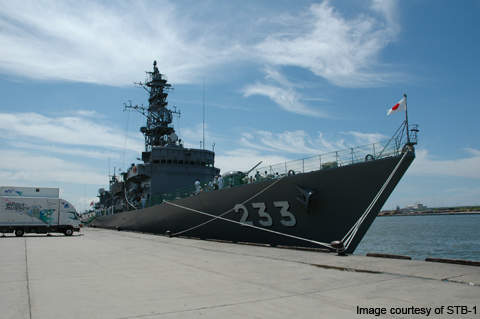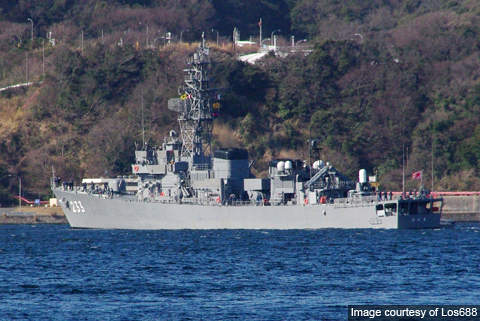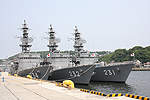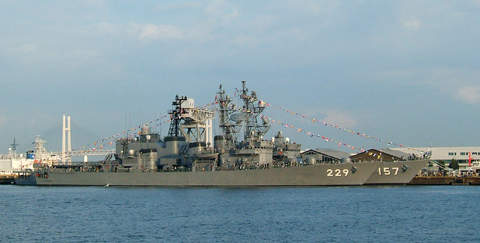Mitsui Engineering & Shipbuilding and Sumitomo Heavy Industries built six Abukuma Class destroyer escorts for the Japan Maritime Self Defence Force (JMSDF). Developed as a successor to the Yubari class, the Abukuma class possesses anti-submarine warfare (ASW) and anti-surface warfare (ASuW) capabilities.
The JMSDF planned to build 11 vessels of this class, but only six were constructed as Hatsuyuki class destroyers entered service with the naval forces. All six vessels of the class were named after the Japanese WWII cruisers.
Abukuma Class destroyer escorts
The keel for the lead ship in class, Abukuma (DE-229), was laid down in March 1988. It was launched in December 1988 and commissioned in December 1989.
Jintsu (DE-230) was laid in April 1988, launched in January 1989 and commissioned in February 1990.
Oyodo (DE-231) was laid in March 1989 and launched in December 1989 for the commissioning in January 1991.
The fourth ship in class, Sendai (DE-232), was laid in April 1989, launched in January 1990 and commissioned in March 1991. Chikuma (DE-233), was laid in February 1991, launched in January 1992 and commissioned in February 1993. The final ship in class, Tone (DE-234), was laid in February 1991 and launched in December 1991 for the commissioning in February 1993.
The Abukuma Class primarily conducts anti-submarine patrol operations. It can also be deployed to attack enemy surface vessels in the coastal area.
Design and features
Abukuma is the first warship in the JMSDF fleet to use stealth technology. The ship’s design incorporates a V-shaped hull for reduced radar cross section. The superstructure design is almost identical to that of the former escort ships that boast limited stealth characteristics.
Abukuma is the first DE type ship to be equipped with air search radar. The vessel is not equipped with the landing area, but features a helicopter vertical replenishment (VERTREP) station.
The class has an overall length of 109m, width of 13.4m, depth of 7.8m and draft of 3.8m. The standard displacement of the warship is 2,000t. The vessel can complement a crew of 120 members.
Weapon systems
The Abukuma Class is armed with four RGM-84 Harpoon anti-ship missiles and a Type 74 eight-round launcher (Japanese license-built version of the American Mark 16 GMLS) for firing anti-submarine rockets (ASROCs). Two triple 324mm Type 68 torpedo tubes onboard can launch Mk 73 or Mk 46 Mod.5 torpedoes.
The main gun fitted is a 76mm 62 calibre OTO Melara compact dual purpose gun. The gun can fire 85 rounds a minute up to a range of 2km. The close-in air defence is provided by a Phalanx close-in weapon system (CIWS). It protects the hostile ship against short range incoming anti-ship missiles. An Mk 31 RAM GMWS Point Defence Missile System was also planned, but not installed.
Sensors / radars
The onboard electronics suite consists of JRC OPS-28 surface or air-search radar, Melco OPS-14C air-search radar, FCS2-21A gun fire control radar and General Dynamics Mk 90 Phalanx fire control system.
The OPS-14 is the Japanese equivalent of the American AN/SPS-49 radar and the OPS-28 is similar to the American TAS Mk 23. The ship is also fitted with OQS-8 (Japanese equivalent of the American DE-1167) bow mounted medium frequency sonar.
Countermeasures
The ship’s electronic warfare system is the NEC NOLQ-6C. It provides surveillance, warning and electronic countermeasures against missiles or air assaults. The ship is also equipped with a Fujitsu OLT-3 jammer and Mk 36 Super Rapid Bloom Offboard Countermeasures (SRBOC) Chaff and Decoy Launching System.
Propulsion
The Abukuma Class is powered by a combined diesel or gas (CODOG) propulsion system integrating two Spey gas turbines and two diesel engines coupled to two shafts.
The two Kawasaki-RR SM1A gas turbines are rated at 19.9MW and the two Mitsubishi S12U MTK diesels are rated at 4.4MW. The propulsion system provides a maximum speed of 27kt.











